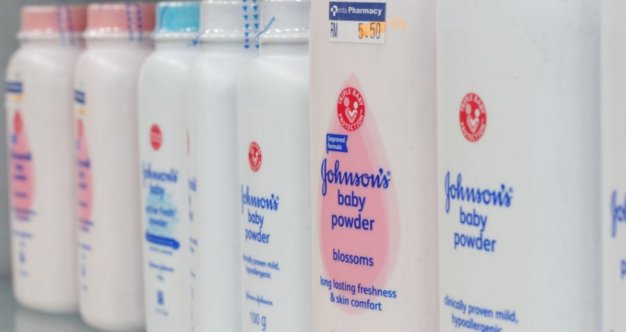One woman had been using Johnson & Johnson baby powder regularly when she was diagnosed with cancer. Her claim: baby powder caused me to get sick.
A California jury awarded $29 million to the plaintiff, Terry Leavitt, who claimed that her illness was caused by asbestos in Johnson & Johnson’s talc-based baby powder, and that she was never properly warned of the cancer risk. Leavitt was diagnosed with mesothelioma in 2017, the cancer most commonly linked to asbestos exposure.
Read MoreBut there is, at the very least, a possibility that the talc based product could have caused her cancer. “With cosmetic products, they contain talc, and talc is a naturally occurring silicate product it’s just magnesium silicate, and it itself is not fibrous. And for any of these to be dangerous, they have to be fibrous, which means long skinny needles. Talc itself is more plate-like. It’s used for industrial material, but it’s also used for some cosmetic products,” says Dr. Sporn. “And depending on where it’s mined from, there is some talc that is contaminated by certain forms of asbestos. Not every talc [mine] is contaminated by asbestos. There is at least a theoretical possibility that talc could be contaminated with asbestos."
Because baby powder does have an air-born component, any asbestos that could be in the powder, could make its way into the lungs. “When you shake out the powder, it becomes airborne. I don't know if you've ever dusted a baby's bottom it creates a little cloud and there's a potential that you could breathe in the dust from that, which may or may not contain asbestos,” says Dr. Sporn.
But lawsuits pertaining to asbestos and cancer are not entirely new. “The legal aspects of asbestos are almost inextricably intertwined with the medical reports at this point,” says Dr. Joseph Friedberg, Head of the Division of Thoracic Surgery at University of Maryland School of Medicine. “You see all the ads on TV and on the buses, because there’s a lot of litigation surrounding this, because no one voluntarily worked with asbestos knowing they were going to get a terminal cancer.”
Mesothelioma is a cancer of the chest cavity. The lungs and the chest cavity work together to keep a perfect balance of fluid in the chest cavity. “Every day, a couple of cups of fluid comes out of the lungs and then gets absorbed by the lining of the chest cavity, primarily along the diaphragm, but really throughout. Anything that throws that balance out of whack can cause that fluid to accumulate. So, at any given time, even though there’s a couple cups of fluid turning over, there’s only maybe a teaspoon of fluid in the chest cavity, too little to even see on a CAT scan.”
But if something disturbs the balance, it can cause disease. “But what happens is that if something disturbs that balance, the most common being, say, congestive heart failure where you got more fluid coming out of the lung than can be absorbed, it's like all the snow melting in the mountains. Your stream overflows, you end up with a lake,” says Dr. Friedberg. “In this case, mesothelioma, or any cancer affecting the pleura, you basically have plugged up the holes where the fluid gets absorbed. And at that point, it's like putting up a dam. In either case, your stream overflows, you end up with a lake.”
But the lake then begins to deposit cells onto the diaphragm, which turns the cancer into a solid. “It disturbs this balance of fluid flow so that you may look in the chest cavity, it may just look inflamed, and all you have is all this fluid,” says Dr. Friedberg. “But ultimately, what happens, almost like rings on a tree, or an onion, it gets deposited, and the tumor becomes this solid, almost wood-like mass, is what I most commonly encounter. And it can range in thickness from a millimeter or two, like an envelope, to literally two or three inches thick, especially along the diaphragm.
Unlike other cancers, which can often be surgically removed if they haven’t yet spread, mesothelioma involves the whole chest, which makes surgery more difficult. “When you have this cancer, there isn’t a square inch in the chest cavity that’s not involved with it, and that’s why it's not a surgical disease. There’s no definite evidence that surgery is beneficial in the treatment of mesothelioma,” says Dr. Friedberg. “That said, there is a subgroup of patients who benefit significantly more, or appear to benefit significantly more, from a surgery-based approach as opposed to the standard of care which is just this combination chemotherapy.”
But even in this case, the process of depositing cells to create the solid tumor will begin again, according to Dr. Friedberg. “For this, you can’t cure anyone with surgery. You take that thing out, so you go in and you take this disease out, it's guaranteed, going to come back locally. It's going to come back in the same place.”
While early talc-based lawsuits claimed talc itself had caused mesothelioma or, in some cases, ovarian cancer, they have now transitioned to claims specifically about asbestos in talc-based products. In three asbestos related claims, plaintiffs have been awarded up to $4.69 billion in damages in an ovarian cancer case, while Johnson & Johnson has won three other cases. Five additional cases have ended in a hung jury. Johnson and Johnson has appealed all plaintiff verdicts.
Leavitt’s trial was nine weeks long, and it took the jury two days to reach their verdict. Jurors found both that the product was defective, and that the company had failed to properly warn about product defects. Money awarded to Leavitt was compensatory, meaning that it repaid Leavitt and her husband for their loss. The jury did not offer punitive damages to more actively punish the company for its behavior.
Learn more about SurvivorNet's rigorous medical review process.


